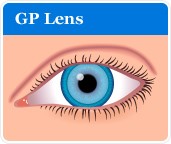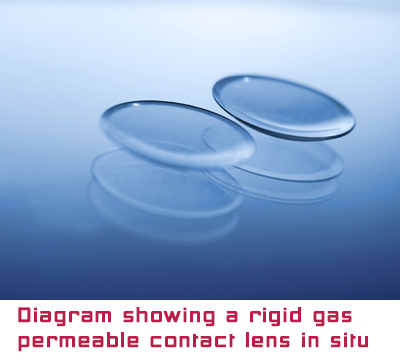Rigid gas permeable contact lenses
Their firm texture means that they don’t contain liquid elements and this not only means that they don’t dehydrate outside the eye or the lens case but it most importantly means that RGPs resist deposits and are much less likely to harbor bacteria than soft contact lenses.
Rigid Gas Permeable contact lenses Rigid Gas Permeable contact lenses are widely known as RGPs and probably account for about the 6-8% of all contact lens wearers. RGPs are the offspring of the older type of lenses known as Hard contact lenses. Hard lenses were the original type of this custom made contact lens philosophy and were made from materials (primarily PMMA) not permeable to oxygen (not allowing oxygen to pass through them and towards the cornea-this is the transparent outermost tissue of your eye upon which your contact lenses rest). RGPs are made of durable, firm materials that do allow the transmission of oxygen to the cornea. Their firm texture means that they don’t contain liquid elements and this not only means that they don’t dehydrate outside the eye or the lens case but it most importantly means that RGPs resist deposits and are much less likely to harbor bacteria than soft contact lenses. The possibility of an eye infection is for that reason much less for RGP wearers than for soft contact lens wearers.
Adjusting to RGPs takes a bit more than adjusting to soft contact lenses and one of the reasons for this is because they move a bit more than soft contact lenses do with every blink. It’s their small size and not their firm texture responsible for the harsh sensation experienced just after the very first application in an eye. Their average diameter would be close to 9.8mm and that is smaller than the diameter of the cornea. This means that RGPs actually kind of float on the tear film and that every time you blink, your eyelids ‘hit’ the edge of the lens and you are aware of the lens being there. Your lids gradually do adapt so that you don’t feel the lens with each blink.
RGPs are inserted in the morning, worn for the day and removed in the evening. It is easy to clean and disinfect your RGPs and if you do it with care, your lenses will last much longer than soft lenses. The average suggested life span of a pair of gas permeables is at least one year. RGPs are notorious in dusty environments as dust particles which can get trapped beneath an RGP, can cause irritating pain to the wearer. They are not great for sports either since they can decenter with sudden quick eye movements. This can cause pain and blurred vision.
Nothing is however compared with the excellent optics that RGPs provide to their wearer. In every day optometric practice work, they give excellent vision to individuals with high prescriptions and high astigmatism in particular. In hospital routine team work, ophthalmologists very often request trial RGP fits just to reveal the exact visual potential of an eye prior or after specific eye surgical procedures.

Not all optometrists are familiar or experienced enough to fit RGPs in their routine practice work.

Not all optometrists are familiar or experienced enough to fit RGPs in their routine practice work. RGP fitting and especially specialized RGP fitting, is definitely more complicated and more time consuming if compared with soft lens fitting. It is done by using trial lenses and the actual lens to be ordered for an eye is simply custom made for that eye. The exact shape of the cornea is measured first and the lens will be prescribed in the curvature, diameter and corrective power needed for that eye. RGPs can be ordered in various tints so that you can handle them more easily. They will also be ordered in the specific material suitable for your individual needs. They are done in thinner designs compared to the past and with smoother edges than ever before. They provide good long comfort and the crispiest vision possible.


